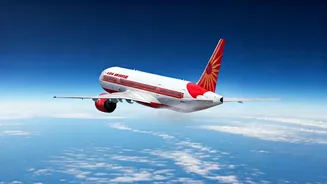Emergency Return Initiated
Air India flight AI191, a journey from Mumbai to Newark, was compelled to return to its origin due to a technical snag that occurred during the flight.
The plane had to turn back mid-air, causing anxiety among the passengers. Details surrounding the nature of the technical issue were not immediately released, but the airline prioritized the safety of everyone onboard. This event caused considerable disruption for the passengers involved, prompting the need for alternative travel arrangements. The incident raised questions about the aircraft's maintenance and pre-flight checks, a crucial part of aviation safety. Aviation authorities initiated an investigation to probe the cause of the technical fault, aiming to prevent similar instances in the future and reaffirm the importance of meticulous aircraft upkeep and adherence to safety norms.
Passenger Experiences & Impact
The abrupt return of the Mumbai to Newark flight left passengers unsettled and facing unexpected travel hurdles. The airline's staff worked to offer support and manage the repercussions of the disruption, which included arranging for alternative flights or accommodations. Many passengers encountered delays in reaching their destinations, causing potential missed connections and interruptions to planned schedules. The sudden change in plans underscored the challenges of air travel. The airline’s immediate focus was to provide prompt and efficient assistance to those affected, addressing their requirements and helping minimize inconvenience. The incident also served as a reminder of the unexpected circumstances that can impact air travel, underlining the necessity for preparedness and flexibility in such situations.
Investigation Underway
Following the incident, aviation authorities launched a thorough investigation to identify the root cause of the technical problem. This process involved a detailed assessment of the aircraft's systems and maintenance records. The goal was to pinpoint the exact nature of the fault, to prevent similar occurrences. Safety investigators examined the aircraft, gathering data to ensure flight safety standards were met. Their findings would be used to improve safety protocols. The investigation considered all possible contributing factors, from equipment malfunctions to potential human errors. The entire process aimed at upholding aviation safety, making sure air travel remains as secure as possible.
Aviation Safety Protocols
The event brought attention to the importance of aviation safety protocols, which are integral to ensuring safe air travel. These protocols include comprehensive aircraft maintenance, rigorous pre-flight checks, and continuous monitoring of aircraft systems during flight. Routine inspections are conducted by qualified professionals. Adherence to these protocols is crucial for detecting and addressing potential issues before they escalate into serious problems. The incident underscored that these measures are vital for preventing accidents and ensuring the safety of passengers and crew. Aviation authorities continuously work to refine and update safety regulations, integrating new technologies and best practices to improve overall safety standards and minimize any risks associated with air travel.
















